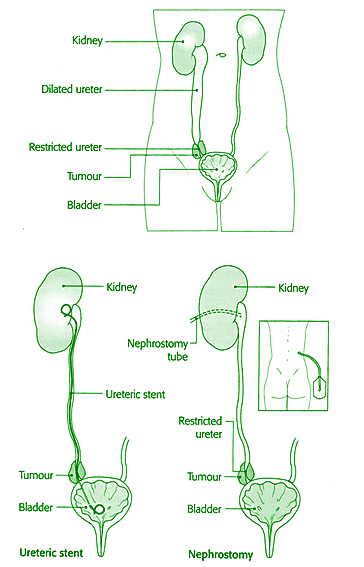|
Nephrostomy and ureteric stents
• The ureter connects the kidney with the bladder, and can become
blocked if the cancer is pressing on it. Severe cramping pain can occur
and the kidney can stop working altogether if the urine flow is not
restored. Nephostomy and ureteric stenting are techniques that can overcome
this type of blockage.
• With a nephostomy, a tube is inserted through the skin of the
back into the kidney, so that the urine can be drained and collected
in a bag. The procedure is carried out under local anaesthetic, and
ultrasound or X-rays are used for guidance.
• A ureteric stent is a narrow flexible plastic tube that can be
passed along the inside of a ureter to allow the kidney to drain normally.
• A retrograde ureteric stent is inserted upwards from the bladder
using a narrow telescope, called a cystoscope, that is inserted through
the urethra. The stent is inserted under a general anaesthetic and,
once in place, extends from the kidney down to the bladder.
• An antegrade stent is inserted through a nephrostomy tube and
then down the ureter and into the bladder.
• Stents are also placed into ureters to help them heal after operations
such as ureteric fistula repairs and urinary diversions. You wiU probably
be given antibiotics to take while you have a ureteric stent in place.
Stents can easily be removed in a short, 20-minute procedure under a
general anaesthetic.
|
|
 |




